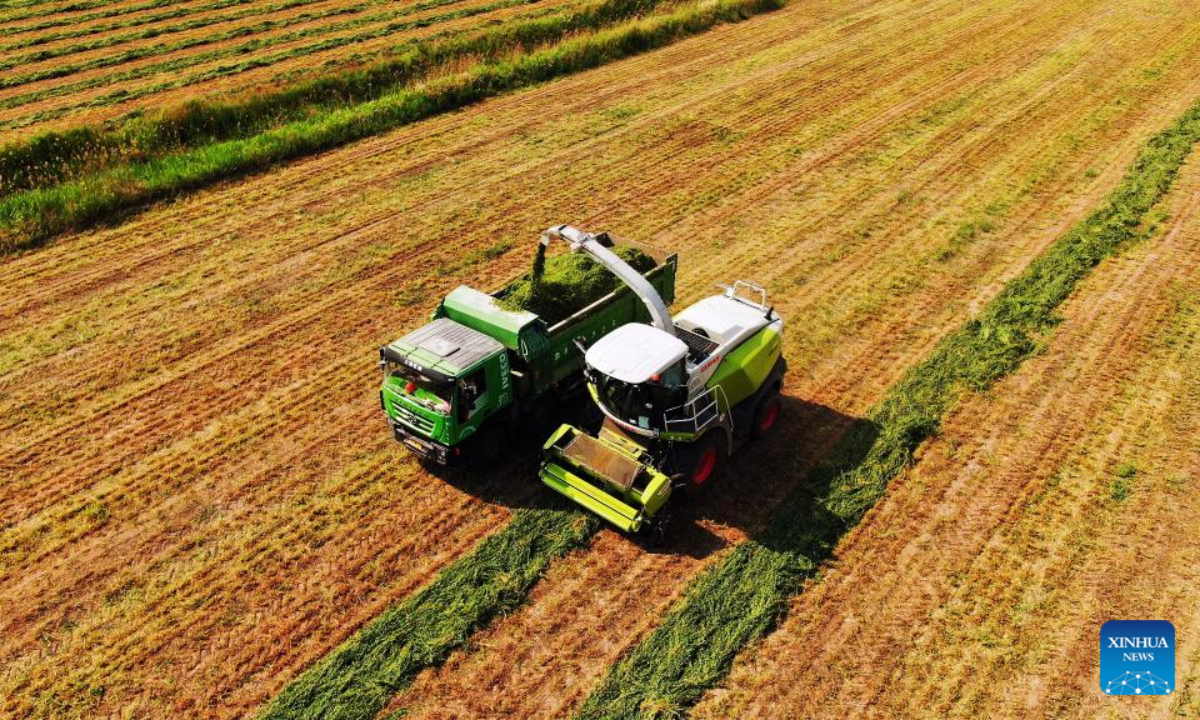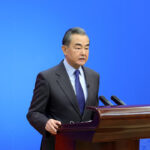Chinese President Xi Jinping has called for enhanced efforts to build up China’s strength in agriculture and do a good job in work on agriculture and rural areas.
Xi made the remarks while attending and addressing the annual Central Rural Work Conference held from Friday to Saturday in Beijing.
Without strong agriculture, there would be no modernized strong country; without agricultural and rural modernization, socialist modernization would be incomplete, Xi told the meeting.
We must go our own way instead of simply copying foreign models of modern agricultural power, and we must rely on our own strength to secure people’s rice bowls, Xi said.
Xi said ensuring a stable and safe supply of food and important agricultural products is always the top priority for building a strong agricultural country, and it is necessary to implement a new round of action to increase 100 billion jin (50 billion kilograms) of grain output, and formulate implementation plans as soon as possible.
We must grasp the two key points, namely arable land and seeds, resolutely guard the “red line” of 1.8 billion mu (120 million hectares) of arable land, gradually build all permanent basic farmland into high-standard farmland, make seed industry revitalization fruitful, and make sure that sources of seeds are under our own control, Xi said.
The conference clarifies the target, mission and path of achieving modernization of agriculture and rural areas, said Li Guoxiang, a research fellow at the Rural Development Institute of the Chinese Academy of Social Sciences.
“The central government’s further deployment of plans for grain safety and rural revitalization during the meeting fully demonstrates the Communist Party of China (CPC)’s profound understanding of the international environment and China’s domestic agricultural development situation,” Li told the Global Times on Saturday.
“Given increasingly volatile international situation as well as increase in extreme weather, food security is among China’s most fundamental interests,” he said. Over the past decade, China has steadily increased its grain production capacity, while promoting rural revitalization by consolidating the foundation of agriculture, rural areas, and work related to farmers.
Faced with the fallout of the COVID-19 pandemic, the impact of extreme weather, and price rises for agricultural materials, China has again secured its people’s rice bowls with a bumper grain harvest in 2022, said Xinhua News Agency on Friday.
Data from the National Bureau of Statistics revealed the country’s grain output totaled 686.55 billion kilograms in 2022, up 3.7 billion kilograms compared to the 2021 figure. This is the eighth consecutive year China has seen its grain harvest exceed 650 billion kilograms.
As the conference pointed to a new action of improving grain output, Li projected that the country may aim to achieve grain output of 700-750 billion kilograms.
The 2022 harvest was hard-won as extreme weather has posed a significant challenge. The rainy autumn season in northern China in 2021 postponed the planting of one-third of winter wheat, while the hottest summer since 1961, when China started to keep complete meteorological records, exerted pressure on the harvesting of China’s main grain output in 2022.
To overcome difficulties, the CPC Central Committee has implemented a series of measures, such as water conservancy infrastructure construction, stepping up the application and popularization of agricultural technologies, as well as fostering increased public awareness for supporting farming and food production.

This aerial photo shows workers of Shandong Lvfeng Agriculture Group Co., Ltd. harvesting grass in Wudi County, east China’s Shandong Province, in May, 2022. Photo:Xinhua
Improving agricultural technology
China is also transforming its agricultural system with a greater focus on providing more high-quality farm produce and accelerating innovation in agricultural technology.
Xi said that it is necessary to rely on the two-wheel drive of science and technology and reform to accelerate the construction of a strong agricultural country.
It is necessary to keep an eye on the frontiers of the world’s agricultural science and technology, vigorously improve the level of China’s agricultural science and technology, and accelerate the realization of self-reliance and self-improvement for high-level agricultural science and technology, Xi said.
Guided by tackling key agricultural technologies and oriented by the urgent needs of the industry, it is necessary to take advantage of a new system for mobilizing the resources nationwide to build an agricultural science and technology innovation system, Xi said.
The meeting reiterated the need to enhance China’s agricultural technologies and accelerate realizing self-reliance in this regard, reflecting the country’s determination in transforming its agricultural system with a greater focus on providing more high-quality farm produce and accelerating innovation to ensure that sources of seeds and other critical materials are under our own control, Jiao Shanwei, editor-in-chief of industry news website cngrain.com, told the Global Times on Saturday.
Since the 18th CPC National Congress held in 2012, the CPC has been stepping up the application and popularization of agricultural technologies such as improving water conservancy infrastructure construction.
In April, when inspecting South China’s Hainan Province, Xi visited a local seed laboratory and approved of the province’s efforts in exploring an innovative mode for agricultural science and technology to support and guarantee national food security.
The achievements resulted from China’s push for modern agriculture, with more focus on both quantity and quality, innovation-driven farming, as well as green and low-carbon sustainable development, said observers.
From 2012 to 2021, the overall level of mechanization in plowing, sowing, and harvesting of crops increased from 57.2 percent to 72 percent, and the contribution of technological advances to growth in agricultural production had been raised to over 61 percent, according to the Xinhua News Agency on Friday.
Increasing rural residents’ income
Consolidating and expanding the achievements of poverty alleviation is a bottom-line task for comprehensively promoting China’s rural revitalization.
Xi said we must resolutely prevent entire villages returning to poverty, and insist on increasing farmers’ income as a central task, and do everything possible to broaden channels to increase their income.
After eight years of arduous anti-poverty fighting, China has lifted 98.99 million impoverished rural residents living under the current poverty line out of absolute poverty and removed 832 impoverished counties from the country’s poverty list.
To safeguard farmers’ interests, the country has steadily raised the minimum purchase prices of rice and wheat and allocated 40 billion yuan ($5.73 billion) from the central government budget to ease the impact of higher costs in agricultural supplies this year, according to the Xinhua News Agency on Friday.
Li Shihua, a farmer based in Harbin, Northeast China’s Heilongjiang Province, expressed optimism for the development of agriculture as well rural areas under the leadership of the CPC. Li has contracted over 2,000 mu (133 hectares) of land for planting soybeans and corn.
“There are more favorable policies targeting farmers and rural areas now compared with 2009 when I started to contract farmland,” Li Shihua told the Global Times on Saturday, noting that he could access 100 yuan per mu in subsidies for the planting of soybeans and the local government also provides technical guidance for farmers.
Li the farmer expected more support policies to be forthcoming, for example, insurance that help hedge extreme weather, encouraging farmers grow plants and develop specialty industries and attract young people to return to rural areas to boost regional vitality.
(Global Times)




